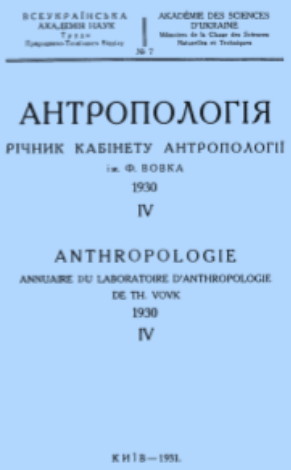Anthropological studies
Anthropological studies. Anthropology is the science dealing specifically with man throughout history that studies his physical appearance and the development of diverse biological characteristics and defines the races by those hereditary physical and psychological features that are common to a given group. The concept of anthropology as a comparative biology of man arose in the 18th century and prevails today in Ukraine and most of Europe. In the English-speaking world, however, anthropology is approached more broadly as the science of man from both a biological and cultural aspect and includes the theory and history of culture, prehistory, ethnology, ethnography, and, to some extent, sociology. As a result, two branches have developed—physical anthropology and cultural anthropology. This articles describes the development of the study of physical anthropology in Ukraine. For an anthropological description of the Ukrainian population, see Physical anthropology.
The earliest attempts at describing the racial composition of the population of Ukraine were made by Herodotus, Hippocrates, and Aristotle. During the Middle Ages such descriptions were recorded by Byzantine and Arab travelers and historians. In modern times the subject has been studied by scholars from nearly every European nation, chiefly by ethnographers. Scientific studies on this subject have appeared only since the late 19th century, however.
The first anthropological studies of the Ukrainian people were written by Pavlo Chubynsky, a Ukrainian; A. Bogdanov, a Russian; Izydor Kopernicki, a Pole; and E. Amy and J. Deniker, both Frenchmen. In more recent times the most important anthropological work on Ukraine was done by the Russian scholars D. Anuchin, A. Ivanovsky, and V. Bunak; the Poles Julian Talko-Hryncewicz and J. Czekanowski; and the Germans H. Günther and E. Eickstedt. Tehir studies, however, were not concerned primarily with Ukraine. The renowned Ukrainian Fedir Vovk was the only scholar who conducted systematic anthropological research in all the Ukrainian ethnic territories.
After the First World War anthropological research in Ukraine was stepped up. It was conducted primarily by the scholars of the Ukrainian Academy of Sciences. The most prominent anthropologists were O. Omelchenko and O. Alesho, who was in charge of the Academy’s Cabinet of Anthropology and Ethnography (est as a museum 1921 and renamed a cabinet in 1922 under Anatolii Nosiv). In 1927 the cabinet was divided into separate cabinets of anthropology and ethnography. The Cabinet of Anthropology published, in 1928–31, four annual volumes of Antropolohiia, which contained archeological and anthropological materials on the inhabitants and ethnic groups of Ukraine. The Kyiv school collected anthropological materials throughout Ukraine, including the Crimea and the Kuban region.
In the 1920s the Anthropological Cabinet of the Ukrainian Psycho-Neurological Institute in Kharkiv published Materialy po antropologii Ukrainy, a review edited by Lev Nikolaev. The Kharkiv school researched primarily the physical and social features of the various population groups. Anthropological research in the 1920s to 1940s was also conducted by the anatomy departments of the universities and medical institutes of Soviet Ukraine.
Government interference and political repression made anthropological research in the 1930s extremely difficult. Research was resumed only in 1955 by the ethnographic section of the Institute of Fine Arts, Folklore, and Ethnography of the Academy of Sciences of the Ukrainian SSR. Owing to the initiative of Maksym Rylsky, Kost Huslysty, and H. Debets, a group devoted to anthropology was formed. In 1974 anthropological research was transferred from this institute to the Institute of Archeology of the Academy of Sciences of the Ukrainian SSR. In 1956–9 the Ukrainian Anthropological Expedition of the Institute of Fine Arts, Folklore, and Ethnography conducted systematic research on the population of Ukraine, as well as a series of paleonanthropological investigations. After 1960 the institute published Materialy z antropolohiï Ukraïny. Some well-known Ukrainian anthropologists of that time are Ye. Danylova, V. Diachenko, H. Zinevych, Ivan Pidoplichko, and K. Sokolova.
In Western Ukraine anthropological research was conducted in Lviv in the 1920s and 1930s by Ivan A. Rakovsky and later by Rostyslav Yendyk, who also continued his work as an émigré. The Lviv school attempted primarily to reconstruct a synthetic picture of racial interrelations in Ukraine and of the racial differences between the Ukrainians and their neighbors (chiefly the Poles and the Russians).
In Soviet Ukraine of the 1970s and 1980s all areas of Ukraine’s anthropology were studied. Soviet anthropologists attempted to prove that the Ukrainians are racially related to the Russians and Belarusians, and thus to refute the view of the Ukrainian ‘nationalist school’ (Fedir Vovk and the Lviv school) that the Ukrainians have some distinctive racial characteristics.
BIBLIOGRAPHY
Vovk, F. Antropologicheskie osobennosti ukrainskogo naroda (Petrograd 1916)
Rakovs'kyi I. ‘Rakovist' slov'ian,’ Zbirnyk Matematychno-pryrodopysno-likars’koï sektsiï NTSh (Lviv 1919)
Iendyk, R. Antropolohichni prykmety ukraïns'koho narodu (Lviv 1934)
Diachenko, V.D. Antropolohichnyi sklad ukraïnskoho narodu (Kyiv 1965)
Zinevich, G. Ocherki paleoantropologii Ukrainy (Kyiv 1967)
Rostyslav Yendyk
[This article originally appeared in the Encyclopedia of Ukraine, vol. 1 (1984).]

